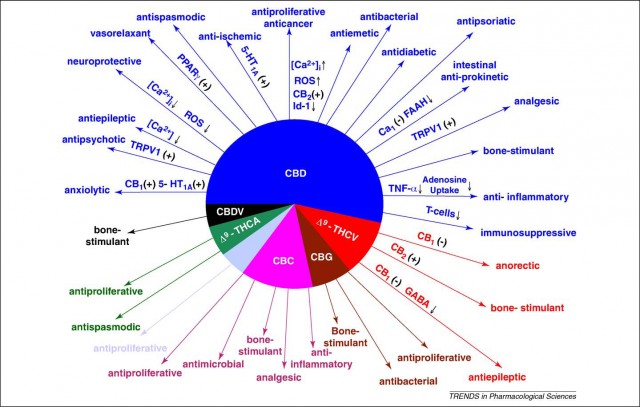Here’s a 101 primer on the major compounds in cannabis and how it impacts the high you experience. With 6,000 Americans trying marijuana for the first time every day, or nearly 2.2M per people year, this is critical information for budding weedists.
Cannabis is the only plant known to produce cannabinoids (“Herbal cannabinoids”), a chemical compound that is also naturally produced in humans (“Endogenous cannabinoids”). Cannabinoids are what produce the mental and physical effects that get you high. THC is the compound almost everyone has heard of in cannabis. Whereas THC is extremely critical to the high we experience, it’s just one of many cannabinoids present in cannabis.
To date, at least 85 different cannabinoids have been isolated in the Cannabis plant. Cannabinoids have countless properties and the scientific community is learning more every day. Some of the many beneficial properties include anti-depressant, anti-inflammatory, anti-anxiety, anti-nausea and even helping to protect the nervous system. There is also the importance of terpenes (aka terpenoids) for the look, smell, and interaction with cannanbinoids to produce each unique high.
The reality is we’ve barely scratched the surface and every day new medical research comes with other potential applications (such as anti-cancer use).
With so many different cannabinoids and potential combinations, many may not realize there are near countless different highs and experiences. Furthermore, even given a particular strain (i.e. Banana Kush), each batch can have differing ratios of cannabinoids depending on the many inputs that go into growing it. Another lever on customizing your high is the temperature you select to burn/heat the cannabis. A vaporizer allows you to precisely pick the temperature to heat the cannabis and since cannabinoids have different boiling points, the temperature you select will release a different combination of cannabinoids into your body and thus a different experience.
Summary Highlights – Major Compounds in Cannabis & Impact To Your High
- Cannabis plants produce compounds called cannabinoids, which produce the high one experiences from smoking marijuana.
- At least 85 different cannabinoids have been isolated from the Cannabis plant.
- Most of the cannabinoids appear in very small amounts (less than .01 percent of total cannabinoids) and are not considered psychoactive, or not important to the ‘high’. Nonetheless, medical research is teaching us exciting new things about even these trace cannabinoids (imagine how much quicker the medical community would learn if it was moved off the Schedule I drug list).
- Tetrahydrocannabinol (THC), Cannabidiol (CBD), and Cannabinol (CBN) are the most critical cannabinoids to understand and how various combinations impact a person’s high.
- THC produces the “head” or “mental” high and is the main psychoactive compound. Without THC you don’t get high. Traditionally, Sativas have higher THC concentrations.
- CBD is primarily responsible for the “body” high. Strains with higher CBD to THC ratios tend to induce less anxiety, i.e. more traditionally Indica strains. CBD helps regulate the high from THC & increases its duration.
- CBN is a byproduct of THC aging & breaking down that produces that “messed up” feeling of fatigue and dizziness. Consume strains with low CBN and store them in dark, cool, and airtight environments.
The Mel Frank article below provides much more detail in an easy to digest format and is well worth a read for any weedist. Mel Frank has been writing on the science and growing of cannabis since the 1970’s with titles such as the Marijuana Grower’s Guide, which was considered by many to be the growing bible of its day.
Source Articles:










